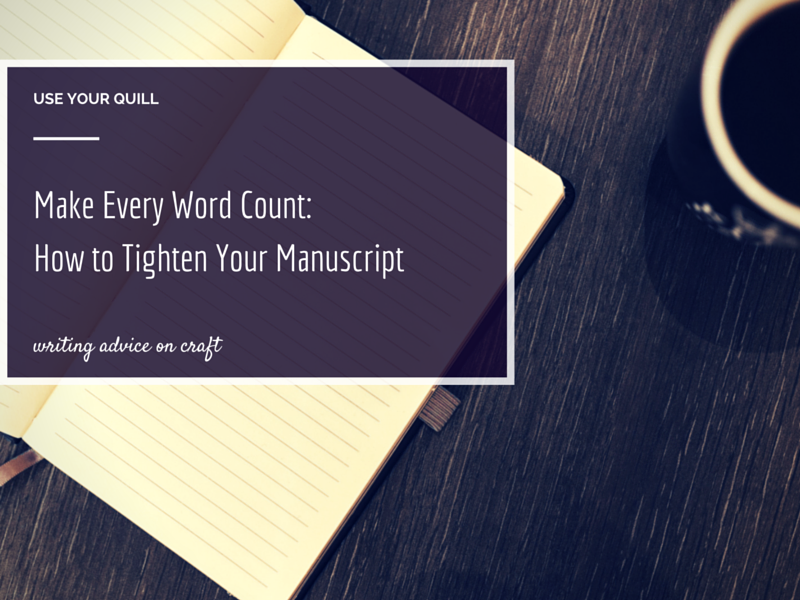How to Tighten Your Manuscript
Revision comes with many challenges, but there is one that can be particularly hard to face—cutting down your manuscript. As a writer, you’ve spent months, maybe years, getting your words onto the page, only now to be faced with the task of removing many of them. Tightening your novel, however, is one of the most important steps in creating a finished work.
Every scene, every paragraph, every sentence should be working towards a purpose. Otherwise, the prose will drag, and no matter how good the story, readers will get bored. The process of cutting down may seem intimidating, but by being aware of common types of filler, you can tackle the job and bring your novel to the next level. Naomi Musch conceives of cutting filler as “trimming the fat” in her article Why You Must Trim the Fat in Your Novel, What it Means, and How to Do It. Think of your story as meat your readers want to devour; in order to give them the best reading experience possible, you need to cut away the fat to get at what your story is really made of.
There are many levels on which to approach the issue of cutting filler from a novel. Entire chapters, characters, and plot points may be cut, or your focus could be on tightening wordy sentences. In this post, we’ll concentrate on how to make cuts to scenes and paragraphs.
So, how do you identify sections that need to go?
When you’re looking at individual scenes and paragraphs in your novel, ask yourself the following questions.
Does this section serve a specific purpose?
Every piece in your novel should be doing work. Perhaps a paragraph is developing your main character, setting the mood, or establishing a conflict. There are many goals a section could be working towards, but it is important to make sure you know what those goals are. In fact, the best scenes serve more the one purpose.
Is the scene simply describing your character moving from point A to point B?
Many times, first drafts will include unnecessary descriptions of characters traveling from one place to the next. Does something integral to the plot happen on your character’s bus ride home from school? If not, there is no reason to devote an entire scene to that trip. You can cover it in one sentence, or, as K.M. Weiland explains in Most Common Writing Mistakes, Pt. 40: Unnecessary Scenes, simply jump time to the next scene which is important to the plot.
Does the scene or paragraph cover something that has already been discussed?
Make sure your scenes are not repetitive. In Are Unnecessary Scenes and Passages Ruining Your Story?, Bronwyn Hemus makes a useful distinction between consistency and repetition. You are being consistent if, for example, your character is always overly cautious and makes choices based on that characteristic. It is repetitious, however, to explain multiple times the experience in your character’s past which has made them cautious. If you have multiple scenes or paragraphs which establish the same thing, try combining them, using the best parts from each. Now you have one strong scene which successfully does the work that multiple scenes were previously attempting.
Is the section filled with unnecessary description?
When describing a character, an action, or a location, it is not necessary to convey every detail from top to bottom. Instead, stick with a few interesting details. If your descriptions tend to run long, try going back to find the most unusual and interesting details. Cut everything else. This way, your description is succinct, evocative, and unique.
Once you have identified the sections that are superfluous, it’s time for the next step—cutting them out. But how do you go about cutting them, you ask. How can you be sure that you won’t be losing something essential to the story? Try the below techniques.
Mentally delete the scene and gauge the effect.
What happens when you remove the scene or paragraph? Think about if anything of vital importance to the story is lost. If so, is there somewhere else you can include that important piece? This can help improve the pacing of your novel. In Something’s Gotta Give: How to Decide What to Cut From Your Novel, Shallee McArthur even suggests using the “cut” function to remove questionable sections out of the manuscript entirely and paste them elsewhere. This will allow you to read your manuscript without those scenes in order to better judge if they can go.
Reevaluate the sections you love the most.
You’ve heard it before: kill your darlings. Many times, writers will be tempted to keep sections with which they’ve fallen in love, even if those sections don’t actually advance the story. It’s important to give the sections you love the most another look to make sure you’re keeping them for the right reason. The great Samuel Johnson has some timeless advice on this topic.
Read over your compositions, and, when you meet a passage which you think is particularly fine, strike it out.
Avoid the info dump.
If you have sections of background information, look them over to see if that information is really relevant to the story. It can be tempting to keep everything in, especially if you have spent hours concocting the finer details of your main character’s upbringing or the world you have created. However, as Jessica Dall states in her article The Unneeded Words, finding just the right amount of description is a fine balance. If the background information you have included is truly important to your story, try to find ways to weave that information throughout the novel when it is relevant, rather than “dumping” it on your reader all at once. QSLA has a full Use Your Quill article about info-dumping and how to transcend to a more graceful way of conveying information. Take the approaches of these two articles to find a much more subtle way of including all of the pertinent details while still keeping the reader interested.
After taking these steps, you will be left with a much tighter novel in which every paragraph and every scene work towards successfully conveying the story you’ve set out to tell.
What is your favorite technique for tightening a manuscript? Feel free to comment below or tweet us at @QuillShift.






0 Comments